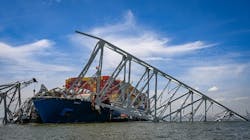Planning the Next Key Bridge
To clean up the debris from the Francis Scott Key Bridge collapse, crews are planning to use precision explosive charges to remove the large section of the Key Bridge next week.
According to Coast Guard Petty Officer Ronald Hodges of the Key Bridge Unified Command, charges will be placed on the truss and the crew still aboard the Dali will shelter in place on the container ship when they are detonated.
Officials at Unified Command determined the explosives would be more effective than cutting apart the piece with powerful saws. This has been the method used so far to separate multiple bridge pieces in the Patapsco River so they can be lifted out by massive cranes.
“It’s the safest and the quickest way, rather than having a guy up there in a crane cutting a truss that’s under a bunch of weight and tension,” Hodges said. “You have these precision cutting devices that are able to serve that same function, but in an instant, rather than doing it over days and days and days, with a worker up there right next to it.”
The goal is to complete the detonations within the next week, Hodges said, but the precise timing will depend on the completion of other steps that must happen first. For instance, crews have been using cranes to relocate some of the items aboard the Dali to one side or another, so that when the large section of truss is removed, the ship will remain stable, Hodges said.
Officials estimate that it will be over four years before a Key Bridge replacement connects Interstate 965 over the Baltimore harbor. However, Maryland is expected to identify its builder by this summer.
On Tuesday during a virtual forum, potential consultants, contractors, and subcontractors asked questions of Maryland Transportation Authority officials regarding the new bridge. It is expected to cost between $1.7 billion and $1.9 billion and be completed by the fall of 2028.
Asked whether state leaders will host site tours or one-on-one meetings with interested companies, transportation authority officials said those are “not anticipated” due to the need for a quick timeline. It’s an “aggressive rebuild schedule,” said Brian Wolfe, the authority’s director of project development.
President Biden has pledged that the federal government will pay for the new span.
--------------------------------------------------
Source: Baltimore Sun
